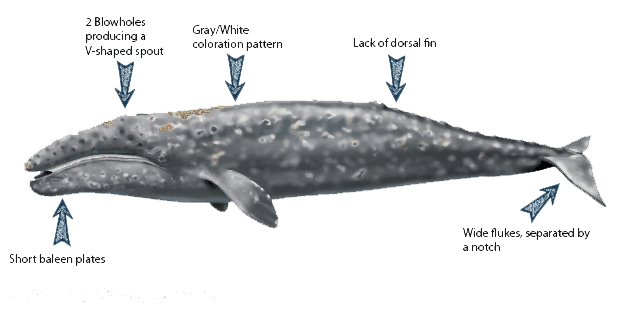Friendliest Whale on Earth – The Gray Whale
The Gray whale is classified as the 6th biggest of the rorqual whales. They are the sole whale species of their family the Eschrichtiidae. Also a baleen whale they have a reputation of being the friendliest whale worldwide.
These whales are very coastal whales, which unfortunately has not played a favorable role for their population as they were very easy targets for whale hunters. However protected in the waters of Mexico since 1946, the healthiest population remains on the west Pacific coast.
Gray whales make one of the longest annual migration of any mammals traveling some 5000 miles (8000km) from summer feeding grounds to winter calving areas in warm waters. Baja California’s waters offer them a comfortable and safe home where their number is in constant increase and their spotting are guaranteed.
If you’re eager to witness Gray whales in their natural habitat, join us and explore our captivating Gray whale watching tours Los Cabos • Mexico • B.C.S.
Appearance
The Gray whale has a large body with a mottled gray coloration and numerous patches of light yellow and orange. These patches are parasites, including barnacles and whale lice that thrive off the skin of the whale.
Their head is narrow and triangular, with a mouth that seems slightly arched, with the blowholes at the centre of its head. They have no dorsal fin, but have a low hump located 2/3 of the way back from the head. Grays have short, square-shaped pectoral fins and a broad rear fluke, also a mottled gray. Often this colouration can have pointed tips in the shape of a heart. A fully grown adult is around 10-15 meters (30-50) feet in length and may weigh around 35 tons.
Population
The gray whale is a truly unique species of mammal. These one-of-a-kind whales have come extremely close to extinction twice in the past three centuries. Due to protection laws and environmentalists, their populations have been restored to about 23000 individuals worldwide.
Location
They occur in two distinct areas in the North Pacific. The main concentrated population is the eastern gray whale, living between the Arctic Ocean and the North American coastline. There is a tiny population of 130 individuals between the Sea of Okhotsk and coastlines of southern Korea, China, Japan, and Russa.
Gray whales make an extraordinarily long migration from the Arctic Ocean to the Baja peninsula of Mexico and back each year. They travel about 12500 miles, 25000 miles a year. This is the longest migration of any mammal. Their drive to migrate is to seek protected tropical lagoons and areas of the Pacific Ocean of Baja to give birth in warmer waters and away from their natural predators.
- Ballena Gris
- Male: 14m
- Female: 15m
- Calf: 4.9m
- Male: 45,000kg
- Female: 45,000kg
- Calf: 680 kg
- Bottom-dwelling crustaceans (amphipods and isopods), e.g. red crab
- Molluscs
- Other invertebrates including Polychaete worms and cephalopods
- Herring eggs
Estimated population:
15,000 – 22,000
Behaviors
Gray whales are very active whales: breaching is commonly observed although it’s reason is unknown, as well as obtaining or spy hopping (raises its head out of the water). They have a reputation of being very friendly whales and often show curiosity towards boats. These whales are often seen tossing and turning in shallow areas or on the bottom of the sea floor, creating circles that can be spotted from the surface due to the unsettled sediment.

Gray whales communicate through a variety of low-frequency sounds such as grunts, rumbles, moans croaks and loud clicks and bangs. These sounds can be heard over great distances underwater. Mysteriously, the function of this effective communication is relatively unknown.
Sociality
Gray whales are not highly social whales, only coming together during the breeding season and during parts of the migration. The courting and breeding behavior is complex, usually involving three to more whales – one female, the rest males. Gestation is about 13.5 months, with young being born in warm, shallow sheltered bays and lagoons. Mothers and calves have strong bonds for the first few months, with the mother often stroking their calf with their flippers. Mothers will fiercely protect their young from attacking killer whales on their migration route.
Feeding
Gray whales feed inshore, and unlike other baleen whales, they are bottom feeders. They hunt for their prey by turning on their side and scooping up sediment from the shallow sea floor. They use their coarse baleen plates and tongue to suck out small invertebrates (amphibious, ghost shrimp, crab larvae) from the soft muddy bottom.
Consequently, they have short baleen plates with long thick bristles. Gray whales can also feed on herring eggs and larvae in eelgrass beds during the spring and summer months. When feeding they often make a sharp turn in shallow water, raising a pectoral fin or tail out of the water, giving the impression that the whale is struggling or stranded.




